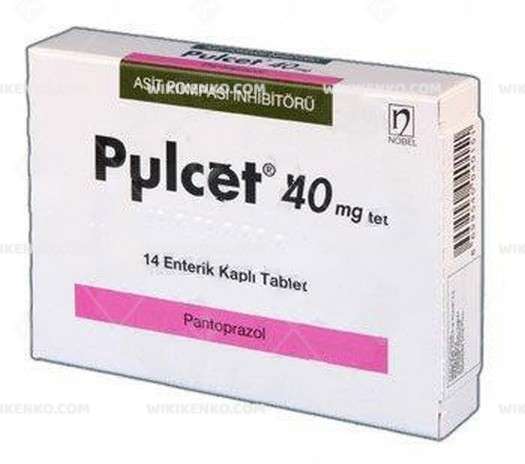Pulcet Enterik Coated Tablet 40 Mg
Pulcet stands as a medication primarily available in the form of enteric-coated tablets, each containing 40 mg of the active ingredient, pantoprazole (in the form of pantoprazole sodium sesquihydrate). These tablets exhibit a unique characteristic – a special coating that prevents them from dissolving in the stomach. This design allows the medication to be absorbed effectively in the less acidic environment of the small intestine.
| Dosage form | |
|---|---|
| Pack size | |
| Potency | 40 Mg |
| Manufacturer | |
| Origin | |
| Generic Name (Ingredient) | Pantoprazole Sodium Sesquihydrate (Equivalent To 40 Mg Pantoprazole) 45.10 Mg |
Assuming your emergency circumstances for this product, visit Urgent Quotation page. Besides, for any pharmaceutical questions, please ask us in the comments section.
Description
Usage Areas
Pulcet is classified under the group of drugs known as “proton pump inhibitors” (PPIs). The primary function of it is to reduce the production of stomach acid, offering therapeutic benefits in various medical conditions:
1. Reflux Esophagitis
Reflux esophagitis, characterized by the backflow of stomach contents into the esophagus, can result in discomfort and complications. Pulcet plays a vital role in alleviating this condition.
2. Ulcers: Duodenal and Gastric
Pulcet is instrumental in reducing the recurrence of duodenal and gastric ulcers caused by H. pylori (Helicobacter pylori) in conjunction with appropriate antibiotics for eradicating this microorganism.
3. Peptic Ulcer Treatment
The medication is a reliable option for the treatment of moderate and severe peptic ulcers, encompassing both duodenal and gastric ulcers.
4. Esophageal Reflux
Moderate to severe cases of esophageal reflux can be effectively managed through Pulcet treatment.
5. Zollinger Ellison Syndrome and Hypersecretory Conditions
Pulcet extends its therapeutic reach to conditions involving excessive secretion, such as Zollinger Ellison Syndrome and other pathological hypersecretory conditions.
Appearance and Packaging
Pulcet tablets feature an oval shape with smooth edges and exhibit a color spectrum ranging from light yellow to yellow. They are made available in two packaging options: 14 tablets or 28 tablets, providing flexibility and convenience for patients.
The Manufacturer
Nobel İlaç Sanayii ve Tic. Anomim Şirketi takes pride in the manufacturing of Pulcet, ensuring quality and adherence to pharmaceutical standards.
Prior to Usage
Before initiating Pulcet treatment, a crucial step is to thoroughly read the patient information leaflet provided with the medication. Understanding how to use it correctly is paramount. For further guidance and clarification, consult your pharmacist or healthcare provider.
Pulcet’s Side Effects
As with any medication, Pulcet may bring about side effects. While individual experiences may differ, some common side effects encompass:
- Injection site reactions (redness, pain, swelling)
- Headache
- Nausea
- Vomiting
- Abdominal or stomach pain
- Diarrhea
- Gas
- Dizziness
- Joint pain
- Weight changes
- Drowsiness
- Sleep problems (insomnia)
This list, while inclusive, does not encompass all possible side effects. Individuals’ reactions can vary, with some experiencing mild effects, others severe, and some not encountering any side effects at all. In the event of adverse effects while using it, prompt consultation with a healthcare provider is essential.
Contraindications
Pulcet (Pantoprazole) should be avoided in specific scenarios:
- Allergies: Individuals with known allergies to pantoprazole or related medicines such as lansoprazole, omeprazole, Nexium, Prevacid, Prilosec, and others should refrain from using Pulcet.
- Past Severe Reactions: If you have previously experienced breathing problems, kidney issues, or severe allergic reactions after taking pantoprazole, Pulcet usage should be avoided.
- Rilpivirine Medication: If you are taking medicine containing rilpivirine (Edurant, Complera, Juluca, Odefsey), Pulcet is not recommended.
- Extreme Sensitivity: Pulcet should be avoided in individuals with extreme sensitivity to any of its ingredients.
- Pernicious Anemia: Patients diagnosed with pernicious anemia should also abstain from using it.
For comprehensive information and to assess the suitability of Pulcet for your specific case, consult your healthcare provider. Engaging in a discussion regarding all your medications and health conditions is essential to ensure safe use.
Recommended Dosage
The recommended dosage of Pulcet (Pantoprazole) varies based on the medical condition being treated:
- For reflux disease, the recommended dose typically comprises 20 mg per day, administered for 2-4 weeks.
- In cases of associated esophagitis, treatment may extend to 4-8 weeks.
- To prevent ulcers and erosions in the stomach/intestines caused by NSAIDs in individuals at risk, a daily dose of 20 mg is recommended.
- For reflux esophagitis, dosages can range from 20 mg to 40 mg per day.
- Treatment of Zollinger-Ellison syndrome often commences with an 80 mg daily dose, divided into two administrations. If necessary, this may be temporarily increased to 160 mg. The duration of treatment is not limited.
- In cases requiring intravenous injection to treat duodenal and gastric ulcers, a recommended dose of 40 mg is administered once daily for 7-10 days.
Please note that these are general recommendations, and the precise dosage should be determined by a healthcare provider based on individual patient requirements. Always adhere closely to your healthcare provider’s instructions when using this medication.
Onset of Action
The onset of action for Pulcet (Pantoprazole) can vary among individuals due to factors such as age, weight, metabolism, and overall health status. Typically, proton pump inhibitors like Pulcet commence their acid-reducing effects within approximately one hour of administration, with the maximum impact occurring within two hours. However, noticeable relief from symptoms may take 24 to 48 hours after the initial dose. For full therapeutic benefits, it may require several days to a week.
To gain insights tailored to your unique circumstances, consult your healthcare provider.
Conclusion
In conclusion, Pulcet, with its active ingredient pantoprazole, serves as a valuable tool in managing a spectrum of gastrointestinal conditions. Understanding its composition, usage areas, precautions, side effects, contraindications, recommended dosage, and onset of action empowers individuals to make informed decisions in consultation with healthcare professionals. Your healthcare provider remains your trusted partner in optimizing its benefits while ensuring your health and well-being.
Key Insights
| Attribute | Details |
|---|---|
| Active Ingredient | Pantoprazole (as pantoprazole sodium sesquihydrate) |
| Form | Enteric-coated tablets (40 mg) |
| Usage Areas | Treatment of reflux esophagitis, ulcers, and more |
| Appearance and Packaging | Oval-shaped, light yellow to yellow tablets in packs of 14 or 28 |
| Manufacturer | Nobel İlaç Sanayii ve Tic. Anomim Şirketi |
| Price (Turkish Lira) | 24.62 |
1 review for Pulcet Enterik Coated Tablet 40 Mg
Use the form below to report an error
Please answer the questions as thoroughly and accurately as possible. Your answers will help us better understand what kind of mistakes happen, why and where they happen, and in the end the purpose is to build a better archive to guide researchers and professionals around the world.
The information on this page is not intended to be a substitute for professional medical advice, diagnosis, or treatment. always seek the advice for your physician or another qualified health provider with any questions you may have regarding a medical condition. Always remember to
- Ask your own doctor for medical advice.
- Names, brands, and dosage may differ between countries.
- When not feeling well, or experiencing side effects always contact your own doctor.
Cyberchondria
The truth is that when we’re sick, or worried about getting sick, the internet won’t help.
According to Wikipedia, cyberchondria is a mental disorder consisting in the desire to independently make a diagnosis based on the symptoms of diseases described on Internet sites.
Why you can't look for symptoms on the Internet
If diagnoses could be made simply from a textbook or an article on a website, we would all be doctors and treat ourselves. Nothing can replace the experience and knowledge of specially trained people. As in any field, in medicine there are unscrupulous specialists, differences of opinion, inaccurate diagnoses and incorrect test results.



Oksana Yastrubchak –
I do not know yet
Medical Guidance Center –
Hello Oksana, this is Wikikenko,
If you require additional details regarding this particular product, kindly refer to the description tab that is accessible on this page. Don’t hesitate to inquire if you have any questions about Pulcet Tablet.